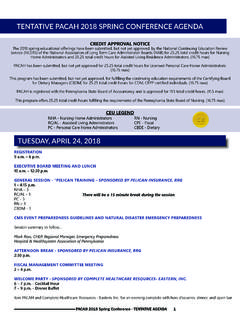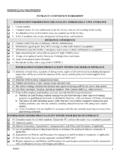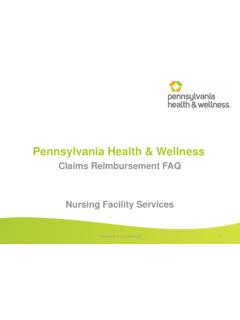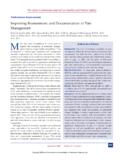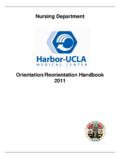Transcription of Successful Restorative Program - PACAH
1 Successful Restorative Program When Therapy and Nursing Collaborate AdvantageCare Rehabilitation / Advantage Home Health Services Kathy Kemmerer, NAC, RAC-CT , CPRA. CMI Specialist & Medicare Reimbursement Specialist Dave Lishinsky, PT. VP of Clinical Compliance Disclaimer Please note that this presentation is for informational purposes only. The information is intended for the recipient's use only and should not be cited, reproduced or distributed to any third party without the prior consent of the authors. Although great care is taken to ensure accuracy of information neither the authors, nor the Advantage companies can be held responsible for any decision made on the basis of the information cited. No one should act upon such information without appropriate professional advice after a thorough assessment of the individual situation.
2 2. Objectives 1. Learn the importance of implementing a comprehensive RNP. in your SNF. 2. Learn how communication and collaboration between nursing and therapy will lead to a Successful RNP. 3. Understand the impact a RNP can have on your Quality Measures and 5 Star Rating 4. Identify clinical programs that will help decrease hospitalizations and ED visits 5. Learn how to audit a CMI report to identify RNP opportunities 3. Introduction 4. Restorative Nursing programs 5. Restorative Nursing programs Technique: Activities provided by Restorative Nursing Staff 1. Range of Motion (passive): Code provision of passive movements in order to maintain flexibility and useful motion in the joints of the body. Coding tip: The caregiver moves the body part around a fixed point or joint through the resident's available range of motion. The resident provides no assistance.
3 These exercises must be individualized to the resident's needs, planned, monitored, evaluated and documented in the resident's medical record. 2. Range of Motion (active): Code exercises performed by the resident, with cueing, supervision, or physical assist by staff. Coding tip: Any participation by the resident in the ROM activity should be coded here. These exercises must be individualized to the resident's needs, planned, monitored, evaluated, and documented in the resident's medical record. Include active ROM and active-assisted ROM. 1. Note: For both active and passive range of motion: movement by a resident that is incidental to dressing, bathing, etc., does not count as part of a formal Restorative nursing Program . Range of motion should be dellivered by staff who are trained in the procedures 3. Splint or brace assistance: Code provision of (1) verbal and physical guidance and direction that teaches the resident how to apply, manipulate, and care for a brace or splint; or (2) a scheduled Program of applying and removing a splint or brace.
4 Coding tip: Assess the resident's skin and circulation under the device, and reposition the limb in correct alighment. These sessions are individualized to the resident's needs, planned, monitored, evaluated, and documented in the resident's medical record. 6. Restorative Nursing programs Training and Skill Practice: Activities including repetition, pysical or verbal cueing, and/or task segmentation provided by any staff member under the supervision of a licensed nurse 4. Bed mobility: Code activities provided to improve or maintain the resident's self-performance in moving to and from a lying position, turning side to side and positioning himself or herself in bed. These activities are individualized to the resident's needs, planned, monitored, evaluated, and documented in the resident's medical record. 5. Transfer: Code activities provided to improve or maintain the resident's self-performance in moving between surfaces or planes either with or without assistive devices.
5 These activities are individualized to the resident's needs, planned, monitored, evaluated, and documented in the resident's medical record. 6. Walking: Code activities provided to improve or maintain the resident's self-performance in walking, with or without assistive devices. These activities are individualized to the resident's needs, planned, monitored, evaluated, and documented in the resident's medical record. 7. Restorative Nursing programs 7. Dressing and/or grooming: Code activities provided to improve or maintain the resident's self-performance in dressing and undressing, bathing and washing, and performing other personal hygiene tasks. These activities are individualized to the resident's needs, planned, monitored, evaluated, and documented in the resident's medical record. 8. Eating and/or swallowing: Code activities provided to improve or maintain the resident's self-performance in feeding oneself food and fluids, or activities used to improve or maintain the resident's ability to ingest nutrition and hydration by mouth.
6 These activities are individualized to the resident's needs, planned, monitored, evaluated, and documented in the resident's medical record. 8. Restorative Nursing programs 9. Amputation/prosthesis care: Code activities provided to improve or maintain the resident's self-performance in putting on and removing a prosthesis, caring for the prosthesis, and providing appropriate hygiene at the site where the prosthesis attaches to the body ( , leg stump or eye socket). Dentures are not considered to be prostheses for coding this item. These activities are individualized to the resident's needs, planned, monitored, evaluated, and documented in the resident's medical record. 10. Communication: Code activities provided to improve or maintain the resident's self-performance in functional communication skills or assisting the resident in using residual communication skills and adaptive devices.
7 Example: instructing, cueing and using a communication board with a resident who is hearing and/or verbally impaired. These activities are individualized to the resident's needs, planned, monitored, evaluated, and documented in the resident's 9. medical record. Restorative Nursing NOTE: Restorative Nursing programs can not be combined but can be performed in succession: I need to do AROM before I can do my ADLs safely. NOTE: Residents with dementia learn and retain by repetition. Nursing interventions that promote the resident's ability to adapt and adjust to living as independently and safely as is possible The nurse assistant who totally feeds Mrs. W. has noticed in the past week that Mrs. W. has made several attempts to pick up finger foods. She believes Mrs. W. could become more independent in eating if she received close supervision and cueing in a small group for Restorative care in eating.
8 Careful observation by this CNA, has led to a Restorative Program being implemented improving her quality of life. Restorative nursing programs affect resident quality of life by allowing 10. the resident to be as independent as possible Restorative Nursing Restorative nursing is person-centered, whole-person nursing care. The difference in a formalized Restorative nursing Program is that activities of daily living are considered therapeutic modalities (modality is equipment used to aid that resident in performing their Restorative nursing Program ). Certified nursing assistants are trained to instruct, encourage, guide, and assist residents to perform self-care skills with as much independence as possible. Depending on the resident, a loss of independence could be interpreted as a behavior issue or being resistive to care, when in truth, that resident's independence may be their personal values.
9 Quality of life is a natural outcome of Restorative care. Functional decline can lead to depression, withdrawal, social isolation and complications of immobility. 11. Rules of Restorative Nursing Are Specific Restorative nursing care must be given daily At least 15 minutes, over the course of one full day, of care are required to qualify for one day of reimbursable care Example: a resident might receive PROM for 10 minutes on the day shift plus 10 minutes on the evening shift to equal 20. minutes for the day 15 minutes cannot be figured by adding time from different programs Example: 10 minutes of PROM and 5 minutes of ambulation does not = 15 minutes in either Program 12. Rules of Restorative Nursing Are Specific The care plan must include objective, measurable goals The care plan must show that a licensed nurse periodically evaluates the resident's progress, and changes the care plan if needed: Refer to Documentation slide Documentation can take place within a software Program It is important to document the resident's refusal of care as well as their inability to perform programs .
10 13. Documentation Requirements Care must be taken to assure that documentation justifies the necessity of the Restorative programs provided. Measurable objective and interventions must be documented in the care plan and in the medical record. If a Restorative nursing Program is in place when a care plan is being revised, it is appropriate to reassess progress, goals, and duration/frequency as part of the care planning process. Good clinical practice would indicate that the results of this reassessment should be documented in the resident's medical record. Evidence of periodic evaluation by the licensed nurse must be present in the resident's medical record. When not contraindicated by state practice act provisions, a progress note written by the Restorative aide and countersigned by a licensed nurse is sufficient to document the Restorative nursing Program once the purpose and objectives of treatment have been established.
